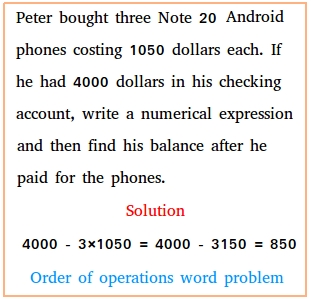Order of operations word problems
Learn how to write order of operations word problems into numerical expressions and learn how to solve them using the order of operations.
Order of operations word problems
Example #1:
Sylvia bought 4 bananas for 50 cents each and 1 apple for 80 cents. Write a numerical expression to represent this situation and then find the total cost in dollar.
4 × 50 + 80
= 200 + 80
= 280 cents or 2.80 dollars
The total cost is 2.80 dollars
Example #2:
Robert bought 2 burgers for $3.50 each and 3 medium French fries for $1.20 each. Write a numerical expression to represent this situation and then find the cost.
2 × 3.50 + 3 × 1.20
= 7 + 3.60
= 10.60
Example #3:
Martha pays 20 dollars for materials to make earrings. She makes 10 earrings and sells 7 for 5 dollars and 3 for 2 dollars. Write a numerical expression to represent this situation and then find Martha's profit?
7 × 5 + 3 × 2 - 20
= 35 + 6 - 20
= 41 - 20
= 21
Example #4:
John bought 3 pants for 25 dollars each and paid with a one hundred-dollar bill. Write a numerical expression to represent this situation and then find how much money John gets back from the cashier?
100 - 3 × 25
= 100 - 75
= 25
Tricky order of operations word problems
Example #5:
The price of a shirt is 100 dollars. The store manager gives a discount of 50 dollars. A man and his brother bought 4 shirts and then share the cost with his brother. Write a numerical expression to represent this situation and then find the price paid by each brother.
Solution(100 - 50) × 4 ÷ 2
= (50)× 4 ÷ 2
= 200 ÷ 2
= 100
The price paid by each brother is 100 dollars
Example #6:
Peter withdrew 1000 dollars from his bank account today. He uses 500 to fix his car. Then, he divide the money into 5 equal parts and gave away 4 parts and kept 1 part for himself. Finally, he took to wife to the restaurant and spent 60 dollars on meals. Write a numerical expression to represent this situation and then find how much money Peter has now?
(1000 - 500) ÷ 5 - 60
= (500) ÷ 5 - 60
= 100 - 60
= 40
Peter has 40 dollars left.
Take a look also at the order of operations word problem below
